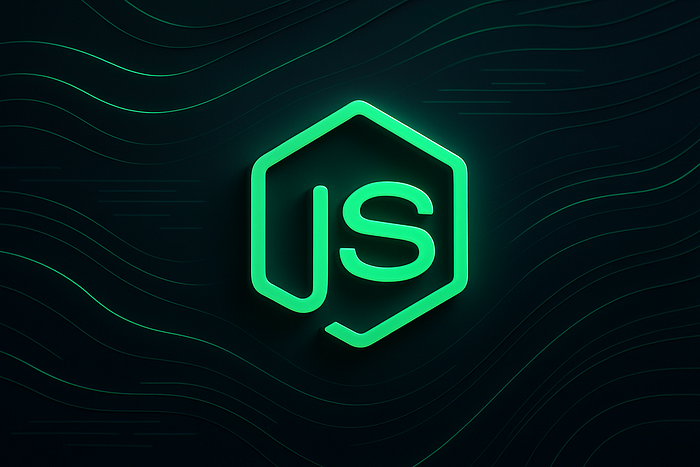When I wrote my first backend in Node.js, it worked — but it wasn't pretty. It was a tangle of routes, business logic, and error messages scattered across files.
Fast forward a few years, and I've learned a simple truth:
Clean Node.js code isn't about fancy patterns — it's about discipline.
Here are 10 Node.js best practices that will make your apps more stable, maintainable, and production-ready.
1. Use a Clean Project Structure
Your project structure is the backbone of maintainability. Avoid dumping everything into app.js.
Bad:
project/
├─ app.js
├─ routes.js
└─ db.jsBetter:
project/
├─ src/
│ ├─ routes/
│ │ └─ user.routes.js
│ ├─ controllers/
│ │ └─ user.controller.js
│ ├─ services/
│ ├─ models/
│ ├─ middlewares/
│ └─ app.js
└─ package.json✅ Why: Makes the app scalable and easy to onboard new devs.
2. Handle Errors Gracefully
Don't let unhandled exceptions crash your server. Wrap critical logic with try/catch or middleware.
Example:
app.get('/user/:id', async (req, res, next) => {
try {
const user = await getUserById(req.params.id);
if (!user) throw new Error('User not found');
res.json(user);
} catch (err) {
next(err);
}
});
// Global error handler
app.use((err, req, res, next) => {
console.error(err.message);
res.status(500).json({ error: err.message });
});✅ Why: Prevents app crashes and gives meaningful feedback to clients.
3. Use Environment Variables Properly
Never hardcode secrets or configuration values.
Example:
import dotenv from 'dotenv';
dotenv.config();
const PORT = process.env.PORT || 3000;
const DB_URI = process.env.DB_URI;Store sensitive values in a .env file:
PORT=3000
DB_URI=mongodb+srv://username:password@cluster✅ Why: Secures secrets and makes deployments flexible.
4. Modularize Your Code
Avoid writing everything in one place. Split business logic into controllers, services, and utilities.
Example:
// user.controller.js
import { getUserById } from '../services/user.service.js';
export const getUser = async (req, res, next) => {
try {
const user = await getUserById(req.params.id);
res.json(user);
} catch (err) {
next(err);
}
};✅ Why: Encourages reusability and separation of concerns.
5. Use Async/Await Instead of Callbacks
Old callback code is messy and error-prone. Use modern async/await to keep code readable.
Bad:
fs.readFile('file.txt', (err, data) => {
if (err) return console.log(err);
console.log(data.toString());
});Good:
try {
const data = await fs.promises.readFile('file.txt', 'utf-8');
console.log(data);
} catch (err) {
console.error(err);
}✅ Why: Avoids callback hell and improves maintainability.
6. Validate Incoming Data
Never trust client data. Use validation libraries like Joi or Zod.
import Joi from 'joi';
const schema = Joi.object({
name: Joi.string().min(3).required(),
email: Joi.string().email().required(),
});
app.post('/signup', async (req, res, next) => {
try {
await schema.validateAsync(req.body);
res.json({ message: 'Valid data' });
} catch (err) {
res.status(400).json({ error: err.message });
}
});✅ Why: Protects your backend from invalid or malicious requests.
7. Use Middleware for Common Logic
Middleware is powerful — use it for logging, authentication, error handling, etc.
// logger.js
export const logger = (req, res, next) => {
console.log(`${req.method} ${req.url}`);
next();
};
app.use(logger);✅ Why: Keeps routes clean and reusable.
8. Keep Dependencies Minimal
Every dependency is a potential security risk. Use what you need — no more.
- Regularly audit with:
npm audit- Remove unused packages:
npm prune✅ Why: Fewer dependencies = fewer vulnerabilities and smaller bundle size.
9. Use Proper Logging and Monitoring
Don't rely on console.log in production.
Use libraries like Winston or Pino.
import pino from 'pino';
const logger = pino();
app.get('/', (req, res) => {
logger.info('Home route accessed');
res.send('Hello World');
});✅ Why: Good logging simplifies debugging and improves observability.
10. Write Tests (Even Basic Ones)
Even minimal tests can catch regressions early.
import request from 'supertest';
import app from '../src/app.js';
describe('GET /', () => {
it('should return Hello World', async () => {
const res = await request(app).get('/');
expect(res.statusCode).toEqual(200);
expect(res.text).toBe('Hello World');
});
});✅ Why: A little testing now saves hours of debugging later.
Wrapping Up
Clean Node.js isn't about fancy frameworks — it's about writing code that your future self (or teammate) can actually understand.
✅ Structure your project ✅ Handle errors properly ✅ Secure your secrets ✅ Log intelligently ✅ Test early and often
Start applying just 3 of these best practices today — and your future production bugs will thank you.
Resources & Further Reading
Connect with Me
If you enjoyed this post and would like to stay updated with more content like this, feel free to connect with me on social media:
- Twitter : Follow me on Twitter for quick tips and updates.
- LinkedIn : Connect with me on LinkedIn
- YouTube : Subscribe to my YouTube Channel for video tutorials and live coding sessions.
- Dev.to : Follow me on Dev.to where I share more technical articles and insights.
- WhatsApp : Join my WhatsApp group to get instant notifications and chat about the latest in tech
Email: Email me on dipaksahirav@gmail.com for any questions, collaborations, or just to say hi!
I appreciate your support and look forward to connecting with you!


